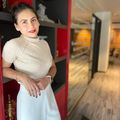Interviews
RISD/Brown/Erfurt students debut unique fabric solar house
28 Jun '14
3 min read
Students from Rhode Island School of Design (RISD), Brown University and the University of Applied Sciences Erfurt, Germany have been hard at work for nearly two years designing and building their one-of-a-kind entry for the 2014 Solar Decathlon Europe -- and the time has come to show their work to the world.
This summer, from June 28 through July 14, the grounds of France's Palace of Versailles will be transformed into a solar-powered village, showcasing 20 sustainable homes built by college students from around the globe. Among them will be a house like no other, Techstyle Haus, with a roof and walls made not of wood or metal, but almost entirely of durable, high performance textiles.
The team -- officially called "Team Inside/Out" in the competition -- spent the spring semester in Providence, Rhode Island constructing the home's structural supports, attaching its signature textile shell and adding the flexible solar panels that will provide all the power the house needs -- and then some. After determining that everything was in working order, the team carefully disassembled the house, packed it into five shipping containers, and shipped it across the Atlantic, where the teams had 10 days to build their houses on site before judging formally opens on June 28.
Designing and constructing a highly efficient solar home with textiles is no simple task, and the team set the bar high. To reach the Passive House Standard -- one that uses 90 percent less energy for heating and cooling than a standard house -- the house's innovative textile wall assembly required a design that combined highly efficient insulation with materials that resist fire and dampen sound.
The plumbing, heating and cooling systems, placed in a compact mechanical core, are the picture of efficiency, running on the power it would take to operate a hair dryer. Solar photovoltaic cells and solar thermal units are used to harness energy. The photovoltaic array covering the curved surfaces is innovative, lightweight, flexible and efficient -- the curvature of which helps to capture more solar energy over the course of a day than a flat system would.
"This project has been a great opportunity for us to reconsider how we think about energy efficiency and the play between function and form," said Helen Bergstrom, Brown chemical engineering student and project engineer. "It has been amazing to see how efficiency optimization can be used to create a structure that is seamless, elegant and comfortable. If someone had told me two years ago that students could design and build a home out of fabric that produces over 50% more energy than it uses I would not have believed it. I think we have all surprised ourselves and our communities."
Rhode Island School of Design
Popular News
































-Ltd..jpg?tr=w-120,h-60,c-at_max,cm-pad_resize,bg-ffffff)





.jpg?tr=w-120,h-60,c-at_max,cm-pad_resize,bg-ffffff)
.jpg?tr=w-120,h-60,c-at_max,cm-pad_resize,bg-ffffff)






